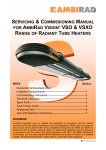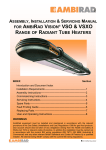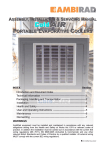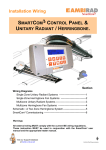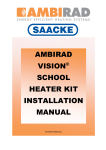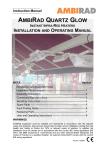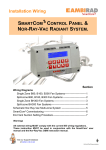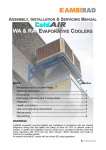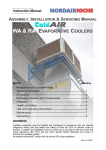Download Ambirad VISION VSO Instruction manual
Transcript
INSTALLATION INSTRUCTION MANUAL FOR AMBIRAD VISION® VSO & VSXO RANGE OF RADIANT TUBE HEATERS INDEX Section Introduction, Document Index & Tools Required Installation Requirements -------------------------------------------------1 User and Operating Instructions ----------------------------------------2 WARNINGS AmbiRad equipment must be installed and maintained in accordance with the relevant provisions of the Gas Safety (Installations and Use) Regulations 1998 for gas fired products. Due account should also be taken of any obligations arising from the Health and Safety at Works Act 1974 or relevant codes of practice. In addition the installation must be carried out in accordance with the current IEE wiring regulations (BS 7671), BS 6896:2005 (Industrial & Commercial) and any other relevant British Standards and Codes of Practice by a qualified installer. All external wiring MUST comply with the current IEE wiring regulations. Introduction. Welcome to the new range of high efficiency AmbiRad Vision radiant tube heaters. Local regulations may vary in the country of use and it is the installers responsibility to ensure that such regulations are satisfied All installation, assembly, commissioning and service procedures must be carried out by suitable qualified competent persons to the statutory regulations in the country of use. When assembling, installing, commissioning and servicing is undertaken on radiant tube heaters specified in these instructions, due care and attention is required to ensure that working at height regulations are adhered to at the mounting heights specified. PLEASE READ this document prior to installation to familiarise yourself with the components and tools you require at the various stages of assembly. All Dimensions shown are in mm unless otherwise stated. The manufacturer reserves the right to alter specifications without prior notice. Document Index. 1 Installation Requirements 1.1 Health & Safety 1.2 Model definitions 1.3 Heater Suspension 1.4 Wall Mounting 1.5 Herringbone systems 1.6 Clearance to Combustibles 1.7 Gas Connection & Supply Details 1.8 Electrical Connections 1.9 Ventilation Requirements 1.9.1 Unflued Radiant Heater (Type A) Mechanical Ventilation Natural Ventilation 1.9.2 Flued Radiant Heater Mechanical Ventilation Natural Ventilation 1.10 Flue & Combustion Air Inlet 1.11 Technical Details 2 User and Operating Instructions 2.1 To Start Heater 2.2 To Switch off Heater 2.3 Routine Maintenance Between Service Intervals 2.4 Frequency of Servicing Tools required. The following tools and equipment are advisable to complete the tasks laid out in this manual. Suitable alternative tools may be used. Saw Trestles Leather Faced Gloves Pozidrive Screwdriver Wrench with Extension 13mm Socket Tape Measure Pop Riveter & 3/16” Rivets Silicone Sealant & Gun 10mm, 12mm & 13mm Spanners 4 & 5mm Allen Keys Herringbone Systems Only 1. Installation Requirements. 1.1 Isolate any electrical supply to the heater and controller before proceeding. additional steelwork should be fitted to enable vertical hangers to be used for suspending the heaters. Health and Safety If there are any doubts as to the strength or suitability of roof steelwork to which heaters are to be suspended, please refer to a Consultant, Architect or owner of the building. The recommended mounting heights for AmbiRad heaters are given in the table below. AmbiRad heaters must be installed in accordance with the relevant provisions of the Gas Safety (Installations and Use) Regulations 1998. Due account should also be taken of any obligations arising from the Health and Safety at Works Act 1974 or relevant codes of practice. In addition the installation must be carried out in accordance with the current IEE wiring regulations (BS 7671), BS 6896:2005 (Industrial & Commercial) and any other relevant British Standards and Codes of Practice by a qualified installer. Isolate all electrical supplies to the heater & controller before proceeding. For your own safety we recommend the use of safety boots and leather faced gloves when handling sharp or heavy items. The use of protective eye wear is also recommended. 1.2 Model Definitions VSOUT = AmbiRad Vision U Tube Unitary heater with painted induced burner, ID Fan, aluminised steel reflectors, end caps, insulation, tube over shields, painted canopies and optional end covers. VSOUH = AmbiRad Vision U Tube Herringbone heater with painted induced burner, Damper, aluminised steel reflectors, end caps, insulation, tube over shields, painted canopies and optional end covers. VSXO = AmbiRad Vision High efficiency U Tube heater with forced burner, recuperative heat exchanger, aluminised steel reflectors, end caps, insulation, tube over shields, painted canopies and optional end covers. 1.3 Model Recommended Mounting Height (m) Horizontal Inclined / wall mounted 15 4.6 - 7.0 4.2 - 5.2 20 5.5 - 9.0 4.4 - 5.8 25 6.0 - 11.0 5.0 - 6.1 30 6.9 - 13.5 6.0 - 7.6 35 7.1 - 14.0 6.5 - 8.3 40 7.5 - 16.0 6.7 - 8.7 45 7.9 - 18.0 6.9 - 9.1 50 8.4 - 20.0 7.2 - 9.5 1.4 Wall Mounting These radiant tube heaters can be wall mounted using the appropriate bracket (AmbiRad part no WMB-13-22-38). When using the wall mounting brackets the heater must be inclined at an angle between 30° and 35°. U Tube Heater Size Required angle Chain length Eyebolt position 15 - 50 30-35° 12 links 1 Figure 3.a. Angle Mounting using the Wall mounting bracket 3. 1 Heater Suspension The heater must be suspended by ALL of the suspension brackets. See fig 3.b. Attachment to the heater support lugs should be made by a ‘speed link’, D shackle or in the case of drop rods, a closed formed hook. The hanging attachments to overhead steelwork etc. must be purpose made to good sound engineering practice or of a proprietary type fixing. They must be adequately fixed and designed to carry the whole weight of the heater. In the event of suitable roof steelwork being unavailable, E * * These angles to be equal and not more than 45°. Vertical suspension chain ideal. Where supports are inclined, maximum recommended angle of inclination is 15°. Typical Speedlink attachment. Shackle method of attachment. Pin must be tightened by pliers. Drop rod with formed hook. note. hook or eyebolt must be closed tight. ON U TUBE VARIANTS THE HEATER SHOULD SLOPE DOWNWARDS TOWARDS THE RETURN BEND BY APPROX. 10mm FOR BOTH HORIZONTAL AND WALL MOUNTED INSTALLATIONS. Vertical or inclined suspension on this plane is acceptable. Where chain supports have an angle of inclination greater than 15° an equal and opposite support is recommended. 15° max. Figure 3.b. Recommended Methods of Heater Suspension. 1.5 Herringbone Systems (VSOUH). The manifold system should be arranged to fall slightly in the direction of the vacuum fan. This ensures that any condensation formed in the manifold on cold start and cool down is not trapped or allowed to drain back into the heater unit. This allows condensate to flow towards the condensate trap located at the vacuum fan end of the manifold system. (See figure 4a below for condensate trap arrangement). The manifold should be supported by chain, stainless steel flexible wire, or other flexible means from the roof structure to allow movement caused by thermal expansion. For 100mm diameter manifold the maximum distance between supports is 2.4m and 3.0m for 150mm diameter. Flexible couplers (supplied by AmbiRad) must be inserted within the manifold system to allow linear expansion to take place and prevent stress and strain on the system. The manifold must be supported either side of the flexible coupler. The exhaust flue should be adequately supported from the building structure and installed in accordance with the British Standard Code of Practice BS 5440: Part 1:2000 – Installation and maintenance of flues and ventilation for gas appliances of rated input not exceeding 70kW net (1st, 2nd and 3rd family gases) A condensate trap assembly must be provided at the end of the manifold system before the hot gas vacuum fan. ‘U’ trap shall be 457mm deep. The end cap of the collecting chamber to be fitted with a flush flanged tank connector. Any protrusion to be removed leaving the inside flush with end cap. Figure 4b. Collecting Chamber Arrangement The end cap should be sealed with silicon jointing compound and pop riveted in position. All condensate drains from the flue collecting chamber to the disposal point shall be corrosion-resistant material of not less than 22mm internal diameter. Copper or copper based alloy shall not be used for condensation drains. See reference BS 6896:2005. Condensate drain pipes must be protected against the effects of freezing. The Type ‘0’ and Type ‘2’ vacuum fans have bottom horizontal discharge with rectangular connections (flanged on the type 0) and must be mounted in that position by means of the fan support stool onto a suitable platform or brackets fixed to the building structure. For details of the fan outlet fixing holes see below. 457.0 The minimum depth of the condensate collecting chamber shall be 305mm and the minimum depth of the condensate drain pipe 213 190 Figure 4a. Condensate Trap Arrangement 305.0 Figure 4c. Type ‘O’ Fan Outlet Dimensions Figure 4d. Type 2 Fan Outlet Dimensions 305.0 For details of fan mounting bracket and fixing down holes see figure 5. Figure 4g. Stainless Steel Telescopic Through The Wall Arrangement (available for Type ‘O’ and Type ‘2’ fans) Figure 4e. Conventional Flue Arrangement Roof Exit. Where a conventional flue is to be installed, AmbiRad supply an aluminium transformation piece to which a 150mm (6ins) diameter flue must be attached. The length of flue which may be connected to the fan outlet must be adequately supported from the building structure. Figure 4f. Conventional Flue Arrangement Wall Exit. Figure 5. Vacuum fan mounting details (Type ‘O’ fan illustrated) Hole Centers Fig 4c/d Hole Centers Fan Type O Type 2 A 124 80 B 38 35 C 175 174 D 7.1 7 E 209 125 F 153 100 G 42 25 H 239 120 J 340 210 K 332 205 L 363 215 Power (watts) 550 120 Running Current (amps) 2.6 0.8 Voltage 230V 1ph 230V 1ph Figure 6. Typical Herringbone system (VSO shown with optional end covers) Dos and don'ts of herringbone system Dos Don’ts Check design pressure drop. Run drains in copper or mild steel pipework. Check for corrosive industrial process in Install system with extra 90° bends without asking proposed building - e.g. cleaning, electroplating, AmbiRad if the system will operate correctly. printers using sugar powder etc. Drain all flue ducts and seal all joints. Install flue with vertical rise without firstly fitting a drain point at it’s lowest level. Secure joints with pop rivets as well as sealing Fit fan with outlet vertical or with top horizontal compound (refer to assembly instructions). discharge. Fit drain traps before and after fans (see figs 4). Fit damper upside down or on it’s side. Fit expansion joints before fan and at Fit damper wrong way round. (see fig14 page 31.) intermediate points on the herringbone system. Run drains in galvanised steel or plastic pipes. Follow guide to combined flue heating system. 1.6 Clearance to Combustibles. The minimum clearances to combustible materials are given in the tables below. These minimum distances MUST be adhered to at all times. Figure 7.a Diagram illustrating the clearance to combustibles (VSXO shown c/w End Covers) B A F D C DIM 'B' E DIM 'D' DIM 'C' VSXO DIM 'C' 20/25 30/35/40 45/50 Above Canopy A 100 100 100 Above Burner / Flued Heat Exchanger B 500 500 500 Above Burner / Heater Outlet Unflued B1 700 700 700 To the Sides C 915 1200 1525 Below Tubes D 2330 2330 2330 From Heater Outlet (UNFLUED) E 570 940 940 End Wall F 390 470 575 Figure 7.b Clearance to combustibles Vision Optima Unitary VSO UT B A F D DIM 'B' C DIM 'C' DIM 'C' VSO UT DIM 'C' 15/20/25 30/35/40 45/50 Above Canopy A 100 100 100 Above Burner / Flued Heat Exchanger B 500 500 500 Above Burner / Heater Outlet Unflued B1 700 700 700 To the Sides C 915 1200 1525 Below Tubes D 2330 2330 2330 From Heater Outlet (UNFLUED) E 570 940 940 End Wall F 390 470 575 Figure 7.c Clearance to combustibles Vision Optima Herringbone VSO UH B A F D DIM 'B' C DIM 'C' DIM 'C' VSO UH Herringbone DIM 'C' 15/20/25 30/35/40 45/50 Above Canopy A 100 100 100 Above Burner / Flued Heat Exchanger B 500 500 500 Above Burner / Heater Outlet Unflued B1 700 700 700 To the Sides C 915 1200 1525 Below Tubes D 2330 2330 2330 From Heater Outlet (UNFLUED) E 570 940 940 End Wall F 390 470 575 1.7 Gas Connection and Supply to the heater not to apply excessive turning force to the internal controls. Before installation, check that the local distribution conditions, nature of gas and pressure, and adjustment of the appliance are compatible. A competent or qualified engineer is required to either install a new gas meter to the service pipe or to check that the existing meter is adequate to deal with the rate of gas supply required. Installation pipes should be fitted in accordance with BS 6896:2005, so that the supply pressure, as stated in Table 4 will be achieved. It is the responsibility of the competent engineer to ensure that other relevant Standards and Codes of Practice are complied with in the country of installation. Pipes of smaller size than the heater inlet gas connection must not be used. The complete installation must be tested for soundness as described in the country of installation. The gas union service cock MUST be fitted in the gas supply close to the heater, but not onto the burner itself. Take care when making a gas connection A flexible hose is installed to allow safe linear expansion of the heater without creating undue stress on the gas supply pipe work. It is therefore important that a tested and certified hose assembly made to ISO 10380 2003, supplied with ½” BSP female cone seat adapters, is installed as per these instructions. It is also important to ensure that expansion is taken up in the body of the flexible hose, and not on its attachment to the pipe work. The cone seat adapter supplied on one end of the flexible gas hose provides a `swivel` action, and must be fitted on the burner using a ½” BSP barrel nipple to provide ease of disconnection for future servicing. This assumes that the heater and fixed gas supply to the isolating valve have been installed. The installation layout described below is the only method recommended by the institute of gas engineers, the hose manufacturer, and AmbiRad and must only be carried out by a qualified/competent gas engineer. Figure 8. Correct Installation of Flexible Gas Connection fig.a fig.b x fig.c x 50 +/- 20mm fig.d fig.e 300 +/- 50mm Arrow denotes direction of expansion. fig.f The methods shown in fig.e and fig.f are unacceptable, due to undue stress on the hose & fittings. Care must be taken to observe the minimum pipe bend diameter (minimum 250mm, maximum 350mm) & pipe expansion distance (minimum 30mm, maximum 70mm) as shown in fig.e. Depending on the specific installation, the flexible gas hose may be routed to the gas cock at any of the following angles in relation to the burner: Vertical 45° angle 90° angle (fig.a) (fig.b) (fig.c) Maximum bend diameter for the 1000mm hose is 450mm. The correct installation as shown will allow for approx 100mm of movement due to expansion. Any other position in between these angles is acceptable. A clearance distance ‘x’ of min 200mm must be observed to allow side door access . Table 4 Gas Supply Pressures Gas Category I2H I3P Natural Gas (G20) Propane (G31) Max Supply Pressure (mbar) 25 45 Min Supply Pressure (mbar) 17 25 Nominal Pressure (mbar) 20 37 Gas Type Gas Supply 1.8 Connection R½ ½in BSP Internal Thread Electrical Connection This appliance must be earthed. Supply 230V 50Hz single phase. Standard heater 116W. Current rating 0.55 amp max (inductive). It is recommended the heater or group of heaters are controlled by thermostats, a time switch and if required manual control switches and a frost thermostat. We recommend use of AmbiRad approved controls. Please refer to control manual for siting and installation details. Fuse: external 3 amp. Where alternative manufactures controls are used, please refer to their instructions for their siting and installation details. All electrical work should be carried out to IEE standards by a competent electrician. The electrical connection to the heater is made by means of a three pin plug-in power connector. Figure 9.a Single Phase Wiring Live, neutral and earth connections should be made via a flexible supply cable to the power connector and routed clear of the heater or tubes. The flexible supply cables should be of 0.5mm² and comply with BS 6500:2000. The wires in the mains lead are coloured in accordance with the following code: Green & Yellow Earth; Blue Neutral; Brown Live Figure 9.b Typical VSOUT Induced Unitary Wiring Connections (end covers not shown) Fused Spur Fan plugs into burner Figure 9.c Typical VSOUH Herringbone Wiring Connections (end covers not shown) Fused Spur Figure 9.d Typical VSXO Powered Burner Unitary Wiring Connections (end covers not shown) Fused Spur Fan plugs into burner Figure 9.e Typical VSXO Powered burner Wiring Connections (end covers shown) Fused Spur Fan plugs into burner Figure 10. Internal Burner Wiring Diagram. Figure 10. Internal Burner Wiring Diagram. FAN L GREY VACUUM SWITCH N SOLENOID VALVE N.C. C. N.O. GREEN/YELLOW VALVE J.S.T. 2 1 3 BLUE EMC FILTER GRN/YLW MAINS INPUT N L BLUE BLUE BLUE MAINS ON GRN/YEL BROWN BROWN 1 2 WHITE MAIN J.S.T. YELLOW GREY 9 10 3 4 7 8 11 12 PINK IGNITER BLUE LAMPS FLAME SENSOR BURNER ON BLACK WHITE BLACK YELLOW GREY BLUE Figure 11. Typical VSO UH Schematic Wiring Connections 1 phase 230V Exhaust Fan Isolator Tail Pipe Isolator Isolator 0.75mm² Screened Cable Isolator Sensor Zone A Isolator 230V 50Hz 13A Controller Mains Supply 1.9 Ventilation Requirements AmbiRad tube heaters can be operated as flued or unflued appliances in accordance with the relevant national requirements in the country of installation. vents to provide adequate ventilation, an example of this calculation is given below: Site Details: 20°c Internal Operating Temperature 0°c Outside Air Temperature 5m between high and low level vents 1.9.1 Unflued Radiant Heater Radiant tube heaters can be operated as unflued appliances so that the concentration of Carbon Dioxide (CO2) at positions where the air will be inhaled does not exceed 0.28%. BS EN 13410:2001 is a guide to achieving this requirement. If the building air change rate exceeds 1.5 per hour or if the heat input is less than 5W/m³, no additional ventilation is required. In addition to the ventilation requirements, consideration needs to be given to the possibility of condensation forming on cold surfaces. It should be noted that the clearance distance around the burner increases when the unit is operated unflued (see section 1.6). It should be ensured that the combustion gases do not impinge on any combustible materials. Mechanical Ventilation Mechanical ventilation must be installed to meet a minimum of 1.5 air changes per hour using appropriately sized fans and interlocked with the heaters. Natural Ventilation BS EN 13410:2001 should be used to size air Following the sizing procedure in BS EN 13410:2001 gives an air exit velocity of 1.6m/s. This equates to a free area vent at both high level and low level of 17.36cm²/kW free area. 1.9.2 Flued Radiant Heater In buildings having an air change rate of less than 0.5 per hour, additional mechanical or natural ventilation is required. For detailed information, please see BS6896:2005 section 5.2.2.2.1 Mechanical Ventilation Mechanical ventilation must be installed to meet a minimum of 0.5 air changes per hour using appropriately sized fans and interlocked with the heaters. Natural Ventilation Low level ventilation openings with a free area of at least 2cm²/kW shall be provided. See section 5.2.2.2.2.1. 1.10 Flue and Combustion Air Inlet Options Induced Burners without Heat Exchangers Please refer to Figure 12 for options. Option 1 - Figure 12a. Air Inlet Attachments Unitary Herringbone Burners (VSO) For non-flued installations, delete items A and B and rotate fan outlet to the HORIZONTAL position away from the burner. Ducted Air Intake Products of Combustion D A E B C Firing tube Products of combustion Ventilation requirements are as detailed in section 1.9 Ducted air must be used in locations where there is airborne dust or where there is a polluted atmosphere e.g. Chlorinated Vapours. Maximum length = 9m Minimum diameter = 100mm Maximum no of bends = 2 A 127mm (5ins) Twin Wall Flue System B Fan Adaptor 7177-SUB C Fan 2501/2507 or 2560 D Optional Ducted Air Intake. VSI-DA E Air Intake (supplied as standard) Maximum flue length = 9.5m @ Ø125mm Maximum no of bends = 2 All flues must terminate vertically. For further information on flue runs, please refer to BS 5440 pt.1 2000 Option 1 - Figure 12b. Air Inlet Attachments Induced Herringbone Burners (VSO) Ducted Air Intake C B A D Firing tube Products of Combustion Ventilation requirements are as detailed in section 1.9 Ducted air must be used in locations where there is airborne dust or where there is a polluted atmosphere e.g. Chlorinated Vapours. Maximum length = 9m Minimum diameter = 100mm Maximum no of bends = 2 A Induced Burner B Air Intake (supplied as standard) C Optional Ducted Air Intake. (see notes) D Damper assembly Option 2 - Figure 12c. Forced Burner with Heat Exchanger (VSXO Standard Flue) For flued products of combustion and no ducted air Products of combustion L J K G G E H Air Inlet Firing tube G F Products of combustion Maximum flue length = 9.5m @ Ø125mm Maximum no of bends = 2 All flues must terminate vertically. For further information on flue runs, please refer to BS 5440 pt.1 2000 Ducted air must be used in locations where there is airborne dust or where there is a polluted atmosphere e.g. Chlorinated Vapours. Maximum length = 9m Minimum diameter = 100mm Maximum no of bends = 2 E Forced Burner F Heat Exchanger G 100mm (4ins) Clips x2 H 100mm (4ins) Flexible Flue J 100mm (4ins) Flexible Flue to Fan K 127mm (5ins) to 100mm (4ins) Reducer L 127mm (5ins) Twin Wall Flue Pipe Ventilation requirements are as detailed in section 1.9 Option 3 - Figure 12d. Forced Burner with Heat Exchanger (VSXO No External Flue) For ducted air and products of combustion to ventilated area J Fresh Air M G Products of combustion to ventilated area E G H G Firing tube F Products of combustion Ventilation requirements are as detailed in section 1.9 E Forced Burner F Heat Exchanger G 100mm (4ins) Clips x2 Ducted air must be used in locations where there is airborne dust or where there is a polluted atmosphere e.g. Chlorinated Vapours. Maximum length = 9m Minimum diameter = 100mm Maximum no of bends = 2 H 100mm (4ins) Flexible Flue J 100mm (4ins) Flexible Flue to Fan M Shroud for unflued heater installation (supplied as standard) Option 4 - Figure 12e. Forced Burner with Heat Exchanger (VSXO with Concentric Flue) For flued products of combustion and ducted air via concentric pipe. Products of combustion IMPORTANT NOTE This option is a type B23 flue system with ducted air and is not a room sealed balanced flue product. Fresh Air Inlet P G J Fresh Air Products of combustion G N E H G Firing Tube Products of combustion E Forced Burner F Heat Exchanger G 100mm (4ins) Clips x2 H 100mm (4ins) Flexible Flue J 100mm (4ins) Flexible Flue to Fan N Flue Extension optional (see max length) avail. 0.25m/0.5m/1.0m P Concentric Flue Terminal F Ventilation requirements are as detailed in section 1.9 Maximum flue length = 9.5m Maximum no of bends = 2 All flues must terminate vertically. For further information on flue runs, please refer to BS 5440 pt.1 2000 Ducted air must be used in locations where there is airborne dust or where there is a polluted atmosphere e.g. Chlorinated Vapours. 1.11 Technical Details. No of Injectors 1 Gas Connection ½ in BSP Internal thread Flue Nominal Bore mm (in) 125 (5) Unitary Fan Motor Details 230 volt 1 phase 50Hz Table 5. Burner Settings - Natural Gas (G20) Heater Model Gas Injector Injector Flowrate Pressure Size Nett (m³/hr) (mbar) (mm) Heat Input kW Gross *Size (h x l x w) Fan Fan *Weight Rating Type (Kg) (A) VSXO20UT 20.0 18.0 1.9 9.2 7 x 1.7 445x4120x826 104 1.0 2507 VSXO25UT 25.0 22.5 2.4 10.0 7 x 1.9 445x4120x826 104 1.0 2507 VSXO30UT 32.0 28.8 3.1 11.5 7 x 2.1 445x5955x826 142 1.0 2507 VSXO35UT 36.0 32.4 3.5 11.5 7 x 2.3 445x5955x826 142 1.0 2507 VSXO40UT 40.0 36.0 3.8 11.0 7 x 2.7 445x5955x826 142 0.5 2560 VSXO45UT 44.0 39.6 4.2 11.6 7 x 2.9 445x7760x826 182 0.5 2560 VSXO50UT 48.0 43.2 4.6 12.8 7 x 2.5L 445x7760x826 182 0.5 2560 VSO15UT 15.0 13.5 1.4 10.2 7 x 1.3 298x4049x826 97 0.5 2501 VSO20UT 20.0 18.0 1.9 11.0 7 x 1.5 298x4049x826 97 0.5 2501 VSO25UT 25.0 22.5 2.4 9.2 7 x 1.8 298x4049x826 97 0.5 2501 VSO30UT 32.0 28.8 3.1 10.8 7 x 2.0 298x5884x826 135 1.0 2507 VSO35UT 36.0 32.4 3.5 9.0 7 x 2.3 298x5884x826 135 1.0 2507 VSO40UT 40.0 36.0 3.8 8.0 7 x 2.7 298x5884x826 135 0.5 2560 VSO45UT 44.0 39.6 4.2 8.9 7 x 2.9 298x7689x826 175 0.5 2560 VSO50UT 48.0 43.2 4.6 9.1 7 x 2.5L 298x7689x826 175 0.5 2560 Gross Nett Gas Flowrate (m³/hr) VSO15UH 15.0 13.5 1.4 10.2 7 x 1.3 298x4049x826 97 VSO20UH 20.0 18.0 1.9 11.0 7 x 1.5 298x4049x826 97 VSO25UH 25.0 22.5 2.4 9.2 7 x 1.8 298x4049x826 97 VSO30UH 32.0 28.8 3.1 10.8 7 x 2.0 298x5884x826 135 VSO35UH 36.0 32.4 3.5 9.0 7 x 2.3 298x5884x826 135 VSO40UH 40.0 36.0 3.8 8.0 7 x 2.7 298x5884x826 135 VSO45UH 44.0 39.6 4.2 8.9 7 x 2.9 298x7689x826 175 VSO50UH 48.0 43.2 4.6 9.1 7 x 2.5L 298x7689x826 175 Heater Model Heat Input kW Injector Pressure (mbar) Injector Size (mm) *Size (h x l x w) *Weight (Kg) Note* For Optima heaters fitted with decorative end mouldings, Length increases by a further 1056mm, weight increases by 6Kg Table 6. Induced VSO Herringbone Settings - Natural Gas (G20) Heater Model Cold HB Pressure Hot HB Pressure mm H2O mbar mm H2O mbar VSO15UH 14.3 1.4 10.2 1.0 VSO20UH 18.4 1.8 10.2 1.0 VSO25UH 25.5 2.5 17.3 1.7 VSO30UH 14.3 1.4 10.2 1.0 VSO35UH 22.4 2.2 16.3 1.6 VSO40UH 20.4 2.0 17.3 1.7 VSO45UH 33.6 3.2 20.4 2.0 VSO50UH 33.6 3.2 20.4 2.0 Table 7. Flue details - Natural Gas (G20) Mass Flow Rate of Flue Gasses (kg/s) Flue Pressure (Pa) Max Flue Resistance Flue Gas Temp (°C) VSXO20UT 0.0130 19 185 VSXO25UT 0.0139 13 205 VSXO30UT 0.0165 33 180 VSXO35UT 0.0167 7.5 185 VSXO40UT 0.0183 35 220 VSXO45UT 0.0210 31 185 VSXO50UT 0.0224 10 195 VSO15UT 0.0114 6 165 VSO20UT 0.0125 19 190 VSO25UT 0.0137 28 225 VSO30UT 0.0189 29 205 VSO35UT 0.0207 24 235 VSO40UT 0.0253 28 240 VSO45UT 0.0253 26 210 VSO50UT 0.0257 27 220 Heater Model Tables 8. Burner Settings - Propane Gas (G31) Heater Model Injector Injector Flowrate Pressure Size (l/hr) Nett (mbar) (mm) Heat Input kW Gross Fan *Weight Rating (Kg) (A) *Size (h x l x w) Fan Type VSO15UT 15.0 13.9 2.18 13.5 7 x 1.0 298x4049x826 97 0.5 2501 VSO20UT 20.0 18.5 2.88 12.4 7 x 1.2 298x4049x826 97 1.0 2507 VSO25UT 25.0 23.1 3.60 13.3 7 x 1.3 298x4049x826 97 1.0 2507 VSO30UT 32.0 29.6 4.60 22.5 7 x 1.3 298x5884x826 135 0.5 2560 VSO35UT 36.0 33.3 5.12 22.4 7 x 1.4 298x5884x826 135 0.5 2560 VSO40UT 40.0 37.0 5.68 18.4 7 x 1.5 298x5884x826 135 0.5 2560 VSO45UT 44.0 40.7 6.25 14.9 7 x 1.7 298x7689x826 175 0.5 2560 VSO50UT 48.0 44.4 6.82 14.3 7 x 1.8 298x7689x826 175 0.5 202126 Heater Model Heat Input kW Injector Pressure (mbar) Injector Size (mm) *Size (h x l x w) * Weight (Kg) Gross Nett Flowrate (l/hr) VSO15UH 15.0 13.9 2.18 13.5 7 x 1.0 298x4049x826 97 VSO20UH 20.0 18.5 2.88 12.4 7 x 1.2 298x4049x826 97 VSO25UH 25.0 23.1 3.60 13.3 7 x 1.3 298x4049x826 97 VSO30UH 32.0 29.6 4.60 22.5 7 x 1.3 298x5884x826 135 VSO35UH 36.0 33.3 5.12 22.4 7 x 1.4 298x5884x826 135 VSO40UH 40.0 37.0 5.68 18.4 7 x 1.5 298x5884x826 135 VSO45UH 44.0 40.7 6.25 14.9 7 x 1.7 298x7689x826 175 VSO50UH 48.0 44.4 6.82 14.3 7 x 1.8 298x7689x826 175 Note* For Optima heaters fitted with decorative end mouldings, Length increases by a further 1056mm, weight increases by 6Kg Table 9. Induced VSO Herringbone Settings - Propane Gas (G31) Model Cold HB Pressure Hot HB Pressure mm H2O mbar mm H2O mbar VSO15UH 19.4 1.9 15.3 1.5 VSO20UH 22.4 2.2 17.3 1.7 VSO25UH 24.5 2.4 17.3 1.7 VSO30UH 27.5 2.7 19.4 1.9 VSO35UH 31.6 3.1 20.4 2.0 VSO40UH 38.7 3.8 23.5 2.3 VSO45UH 36.7 3.6 23.5 2.3 VSO50UH 36.7 3.6 28.6 2.8 Table 10. Flue details - Propane Gas (G31) Mass Flow Rate of Flue Gasses (kg/s) Flue Pressure (Pa) Maximum Flue Resistance Flue Gas Temp (°C) VSO15UT 0.0152 12.5 182 VSO20UT 0.0200 24.9 214 VSO25UT 0.0196 15.0 232 VSO30UT 0.0201 16.2 210 VSO35UT 0.0238 27.4 240 VSO40UT 0.0255 29.9 247 VSO45UT 0.0210 31.4 233 VSO50UT 0.0334 43.6 228 Heater Model Notes Notes 2. User & Operating Instructions. 2.1 To Start the Heater 2.3. Routine Maintenance between Service Intervals 1. Ensure gas supply is turned on. After ensuring that the heater is cold and mains electric isolated, cleaning of the reflectors with a soft cloth and a mild detergent (non solvent based cleaners only) in water can be undertaken. 2. Electrical supply to the controls is on. 3. Ensure that the controls are correctly set i.e.; • • • Additional removal of dust from the radiant tubes, burner and heat exchanger can be undertaken. Clock is correctly set. Heater program is correctly set. Required room temp is correctly set 4. Once the heating controller ‘calls for heat’ power will be supplied to the heater(s). The red neon will then illuminate. 5. After a pre-purge period of 10 seconds the burner will ignite and the amber neon will then illuminate. 6. If lockout occurs press the lockout reset button (if available), or switch off electrical supply and restart after 15 seconds. 7. If lockout occurs three times consecutively switch off and isolate the gas and electricity supplies. 2.4 Frequency of Servicing The manufacturer recommends that to ensure continued efficient and safe operation of the appliance, the heater is serviced annually by a competent person e.g. every year in normal working conditions but in exceptional dusty or polluted conditions more frequent servicing may be required. The manufacturer offers a maintenance service. Contact the AmbiRad Service department. Details are available on request. To Switch Off Heater 1. Switch off electrical supply to the heater. The burner will stop and the fan will shut off. For Service requirements, please contact AmbiRad. For further technical and service support visit our Support Information Database at www.s-i-d.co.uk Document reference number GB/VS/177I/1010 2.2. 2. If the heater is to be switched off for periods in excess of one week it is highly recommended that both the gas and the electrical supplies are turned off. AmbiRad Limited Fens Pool Avenue Brierley Hill West Midlands DY5 1QA United Kingdom. Telephone 01384 489700 Facsimile 01384 489707 Email [email protected] Website www.ambirad.co.uk Technical Support www.s-i-d.co.uk AmbiRad is a registered trademark of AmbiRad Limited. Because of continuous product innovation, AmbiRad reserve the right to change product specification without due notice




























